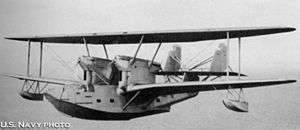Hall XP2H
The Hall XP2H-1 was an American prototype four-engined biplane flying boat of the 1930s. Intended as an experimental very-long-range maritime patrol aircraft, a single example was built. The XP2H-1 was the largest four engine biplane aircraft ever procured by the US Navy.[1]
| XP2H-2 | |
|---|---|
 | |
| Role | Patrol flying boat |
| National origin | United States of America |
| Manufacturer | Hall-Aluminum Aircraft Corporation |
| First flight | November 15, 1932 |
| Primary user | United States Navy |
| Number built | 1 |
Development and design
In 1930, the United States Navy ordered a single example of a large flying boat from the Hall-Aluminum Aircraft Corporation, to meet a requirement for an experimental very-long-range patrol aircraft. The resulting design was designated XP2H-1 and was a four-engined biplane. It had an all-aluminum hull, a scaled-up version of that used in Hall's smaller PH flying boat, which accommodated a crew of six. The wings were of fabric-skinned aluminum construction and were of trapezoidal shape. The engines, Curtiss V-1570 Conquerors were mounted in tandem push-pull pairs between the wings.[2][3]
The XP2H-1 first flew on November 15, 1932, and was extensively tested, demonstrating excellent performance, being 11 mph (18 km/h) faster than predicted.[4] It was possible to cruise on just two engines to extend range, and in 1935, the XP2H-1 was used to carry out a nonstop flight between Norfolk, Virginia and Coco Solo, Panama Canal Zone. The XP2H-1 took 25 hours and 15 minutes to fly the 2,000 miles (3,200 km) distance between these two locations.[5] It was destroyed later in the year attempting a landing in open water.[6] No further P2Hs were built, with the US Navy equipping its patrol squadrons with smaller flying boats such as the Consolidated P2Y.
Specifications
Data from General Dynamic Aircraft and their Predecessors [4]
General characteristics
- Crew: six
- Length: 64 ft 6½ in (19.68 m)
- Wingspan: 112 ft 0 in (34.15 m)
- Height: 25 ft 6 in (7.77 m)
- Wing area: 2,742 ft² (254.8 m²)
- Empty weight: 20,856 lb (9,840 kg)
- Loaded weight: 35,393 lb (16,087 kg)
- Max. takeoff weight: 43,193 lb (19,633 kg)
- Powerplant: 4 × Curtiss V-1570-54 Conqueror V-12 water cooled, 600 hp (448 kW) each
Performance
- Maximum speed: 121 knots (225 km/h, 139.6 mph) at sea level
- Cruise speed: 104 knots (193 km/h, 120 mph)
- Range: 1,870 nmi (3,462 km, 2,150 mi)
- Ferry range: 2,913 nmi (5,394 km, 3,350 mi) (maximum range)
- Service ceiling: 10,900 ft (3,320 m)
- Climb to 5,000 ft (1,525 m): 8.7 min
Armament
- Guns: Five flexibly mounted 0.3 in Browning machine guns in nose, dorsal waist and tail positions
- Bombs: 2,000 lb (909 kg) bombs
See also
Related development
Aircraft of comparable role, configuration and era
References
| Wikimedia Commons has media related to Hall XP2H. |
- Test Pilot Airpower, September 1974 pp. 11-12
- Wegg 1990, pp.113-114.
- Flight January 24, 1935, p.94.
- Wegg 1990, p.114.
- Flight 21 February 1935, p.195.
- Loftin 1985, Chapter 8: Boats in the Sky :Biplane Flying-Boat Developments, 1920-30.
- "For Long Range Patrol". Flight, 24 January 1935. p. 94.
- "A Long Distance Flight" Flight, 21 February 1935, p. 195.
- Boyne, Walter J. "The Flying Hallmarks: The Hall Aluminium Classics". The Best of Wings Magazine. Washington, DC:Brasseys, 2001. ISBN 978-1-57488-368-8. pp. 52–61.
- Loftin, Laurence K. Quest for Performance:The Evolution of Modern Aircraft,SP-468. Washington, DC: National Aeronautics and Space Administration, History Office, Scientific and Technical Information Branch, 1985.
- Wegg, John. General Dynamic Aircraft and their Predecessors. London:Putnam, 1990. ISBN 0-85177-833-X.